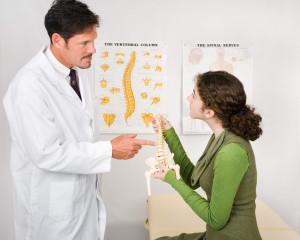Back pain, especially pain in the lumbar spine (lower back), is one of the most common health issues adults face. Almost everyone has experienced or will experience back pain in some form or another. Fortunately, there are many methods for treating lower back pain, such as rest, exercise and stretching, hot therapy, cold therapy, pain medication, and chiropractic care. Opinions vary on what treatment is the most effective, but chiropractic care has become a popular form of treatment for lower back pain in recent years. A great benefit to chiropractic, as opposed to other treatment methods, is that chiropractic care is non-invasive and can help treat back pain without the need for addictive opioids.
How Is Chiropractic Used To Treat Lower Back Pain?
Chiropractic focuses on treating and diagnosing mechanical disorders of the musculoskeletal system that can cause pain, impede range of motion, and create other health issues.
In order to gain the skills and knowledge necessary to diagnose and treat musculoskeletal disorders, chiropractors go through 4 years of undergraduate studies and an additional 4 years of graduate training to become licensed practitioners.
Chiropractors use their extensive training and experience to help develop personalized treatment plans for patients using a variety of techniques. A chiropractor may recommend a particular treatment method or a combination of treatments, exercise and stretching instructions, and self-care recommendations.
The most common method of chiropractic care used to treat lower back pain or other issues is a chiropractic adjustment. Chiropractic adjustment involves manual manipulation of the spine to help correct alignment and provide pain relief. Some other types of chiropractic treatments include:
● Electrical Stimulation Therapy: A chiropractor can use electrical stimulation therapy to send electric waves to a specific area in the body. These waves stimulate blood flow in the targeted area, relieving stiffness and aches, and improving recovery times.
● Hydrotherapy Massage: With the use of a hydrotherapy table equipped with pressurized, warm water jets, a chiropractor can perform a firm and soothing massage that stimulates the body’s soft tissue and increases blood flow, relieving pain and improving motor function.
● K-Laser Therapy: This form of treatment uses a high-powered laser, emitting wavelengths of light, to target damaged tissues, accelerating the natural healing process of the body.
● Spinal Decompression: Chiropractors often use spinal decompression to treat a herniated disc. Using a decompression table, a chiropractor can manually manipulate a herniated disc into its proper place, relieving pressure on the spinal cord.
● Ultrasound Therapy: Commonly used for fetal imaging, a chiropractor can actually use ultrasound therapy to treat back pain by promoting blood flow, aiding scar tissue breakdown, and increasing soft tissue relaxation.
Is Chiropractic Effective At Treating Lower Back Pain?
Claims on the effectiveness of chiropractic treatment can vary depending upon who you ask.
Some people swear by the healing capabilities of chiropractic care while others remain skeptical.
A study of 750 active-duty military personnel was performed in 2018 to look at the effectiveness of chiropractic care compared to traditional treatment methods for lower back pain. Conventional methods of back pain treatment include a balance of rest, hot and cold therapy, exercise and stretching, and pain medication.
Half of the participants in the study were randomly assigned to receive traditional pain treatment while the other half received traditional treatment and 12 chiropractic treatment sessions. The study was conducted over a 6 month period and concluded that participants who received
chiropractic treatment experienced:
● Less pain intensity overall
● Higher satisfaction with their treatment
● Less need for pain medication
● Greater improvement in motor function
● Less disability from symptoms
No serious side effects were reported by the participants who received chiropractic care.
However, roughly 10% of participants who were given chiropractic treatments did experience some adverse effects. This mostly included stiff muscles and joints. It should also be noted that around 5% of the participants who only received traditional care reported similar issues.
Stiff muscles and joints after a chiropractic adjustment is not uncommon. This is typically due to the muscles and joints adjusting to their new alignment. Fortunately, this discomfort is usually short-lived. Most patients feel some measure of pain relief within a couple of days of their session.
What Conditions Can Chiropractic Treat?
Chiropractic is primarily used to treat conditions that stem from spine-related issues. This can include a wide array of conditions, such as:
● Upper back pain
● Lower back pain
● Neck and shoulder pain
● Pain that radiates from the neck down through the arms and hands
● Pain that radiates from the lower back down the buttocks, legs, and feet
● Stiff or aching joints
● Herniated or bulging disks
● Soft tissue damage
● Impact trauma injuries
Patients can seek chiropractic care for treating recent injuries or to help manage pain that has existed for years. Chiropractic can also be used as a preventative treatment. People who have sustained injuries, such as a herniated disc, may wish to see if chiropractic treatment provides significant pain relief before opting for surgery or other invasive treatments.
What To Expect At Your First Visit
When you first go in for a chiropractic consultation, your chiropractor will work with you to diagnose your condition and determine the best course of treatment. You will be asked to provide your family health history, medical history, allergies, and the reason you are visiting.
Your chiropractor will most likely start by asking you some questions to help get a better idea of your symptoms, such as:
● How did your pain start?
● Does your pain worsen when you twist, bend, or move?
● What is your level of pain or discomfort?
● Does your pain prevent you from performing certain activities?
● Have you felt this type of pain before?
● Are you experiencing any other symptoms?
Once your chiropractor has gathered the necessary information, they will perform a preliminary exam to assess the medical and mechanical aspects of your pain. Your doctor will want to look at factors including:
● Alignment
● Muscle tone
● Nerve function
● Your body movement
● Your range of motion
● What movements are causing you pain
Diagnostic imaging tests are usually not needed at an initial chiropractic consultation. However, most chiropractors have the ability to order these tests if needed. Diagnostic tests may include X-rays, MRIs, blood work. If you have already had diagnostic imaging tests performed by another doctor, you can bring the images to your consultation.
After your chiropractor has finished their diagnostic exam, they will discuss the results with you. Your chiropractor will let you know what they believe to be the issue, recommend a treatment plan for you, and explain how they think chiropractic care could benefit you.
Chiropractors often have an extensive referral network. If your chiropractor believes that you would be better served by seeing a physical therapist, spine surgeon, physiatrist, or other specialists, they can refer you to another provider. Some people may benefit from working with a chiropractor in conjunction with another specialist, such as a physical therapist.
Are There Any Risks Associated With Chiropractic Treatment?
One reason people decide to try chiropractic care before seeking treatments such as surgery or opioid pain medication is the relative lack of risk for complications or addiction associated with chiropractic.
The most common risk or adverse effect associated with chiropractic treatment is sore or aching muscles and joints. Some patients may also feel fatigued after a chiropractic treatment session.
Fortunately, these symptoms do not tend to last long and should go away within a day or two. If you do experience new or worsening pain for more than a few days, be sure to contact your chiropractor.
When Should You Visit A Chiropractor For Lower Back Pain?
If you are experiencing new pain in your lower back or lower back pain that has been bothering you for a long time, it may be a good idea to schedule a consultation with a chiropractor.
As we have mentioned before, chiropractic care offers a more conservative approach to treating pain than injections or surgery. In fact, many clinical care guidelines recommend trying chiropractic treatments before considering more invasive procedures.





